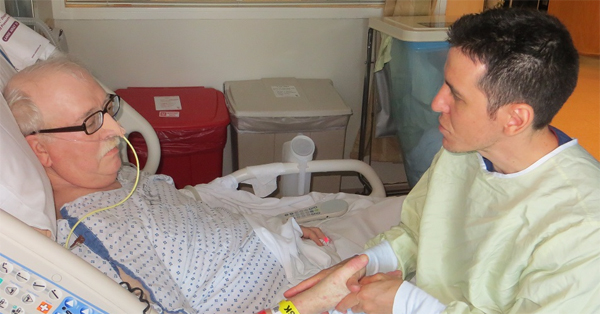
Aromatherapy—the therapeutic use of essential oils—has been shown to have a positive impact on a variety of physical and emotional conditions. A recent study showed that the level of anxiety of women in labor decreased after exposure to orange essential oil. Another showed that lavender helped an elderly population with dementia become calmer. Now, a new aromatherapy program at the Hospital of the University of Pennsylvania is helping patients manage their symptoms … without the use of drugs.
The program, which started in March, offers patients both hand massage with lavender lotion and self-inhalers containing lavender (to help reduce anxiety or stress), peppermint or ginger (both lessen nausea) oils. These therapies do not take the place of treatment; it is complementary. “It’s a part of integrative medicine, viewing the patient as a whole,” said Christin Reddy, MSN, RN, OCN, a nurse on one of HUP’s oncology units.
At HUP, aromatherapy is a nurse-driven practice, part of nursing policy. “It’s something else in a nurse’s toolbox to help with symptoms that are hard to manage,” she said. “And aromatherapy doesn't have the side effects commonly seen with pharmacologic interventions.”
Essential oils are extracts taken from plants, each with specific uses. Pure essential oil is extremely concentrated. Indeed, a ton of lavender produces only 80 cups of lavender oil! As a result, aromatherapy uses the oils in very small doses, typically through direct inhalation, in a room diffuser or as a topical treatment. It is rarely ingested. And, while it’s important to know when to use which essential oils, it’s essential to know when not to use certain oils. For example, peppermint is not safe for pregnant women or for patients with some types of heart disease. “Not having good information can lead to unsafe uses,” said Susan Kristiniak, DHA, MSN, associate director of Palliative Care for Penn’s Health System, who has been a Nurse Aromatherapist for 10 years.
Our sense of smell plays a significant role in aromatherapy. Unlike our other senses, smell is the only one that connects directly to the limbic system in the brain, the area that controls our memories, behavior, and emotions. “Just as certain melodies will calm people, certain smells can be conditioned to a relaxation response as well,” said Richard Doty, PhD, director of HUP’s Smell and Taste Center. And the reaction to smell is quick. It takes about .5 seconds for a smell to register in our brain. Our response to pain is almost double that!
The lavender lotion hand massage elicits a relaxation response but it has other benefits as well, for example, helping improve the nurse/patient relationship. “Nurses are present in the moment, talking with patients as they massage their hand, and making a connection,” Reddy said. “This is a great intervention. It allows us to give patients our full attention.” The act of touch has a soothing impact on patients as well. Nurses also use the massage as an opportunity to educate patients about essential oils.
The self-inhalers, which the patients are taught to use, give patients more control over symptoms – both while in the hospital and at home. The “sniffers” can last up to six months.
Patients are asked to self-rate aromatherapy’s impact, both before and after the therapy. “They rate symptoms like anxiety, nausea, and fatigue on a scale of 1 to 10,” said Melissa Trolene, BSN, RN, CMSRN, of an advanced medicine unit at HUP. Although the program started only a few months ago, “preliminary review of the nurses’ documentation has shown that using aromatherapy has decreased nausea and lessened anxiety when patients are self-reporting before and after the experiences,” Kristiniak said. But patient reactions to this new therapy, such as the one below, tell the true story.
“One patient came from the ED with high respirations. He couldn’t talk and was extremely anxious,” Trolene said. His family stood at the bedside watching as she massaged his hand with lavender lotion. “I could see his respiration level drop from 60 to 40 to 20. His eyes slowly closed. His family was stunned!” When she asked if he wanted a massage on his other hand, he lifted his hand and brought it towards her.
Aromatherapy was initially used on HUP’s oncology units but has since expanded to transplant patients to help with shortness of breath and patients receiving outpatient cancer treatment. Kristiniak said they are now examining its use in women’s health, during delivery and postpartum.
Photo caption: Tim Rowan massages lavender lotion onto the hand of James Zogbaum to help him relax.